Are You Ready for Digital?
The new digital age in our workplace isn’t coming, it’s already here, says Craig Smith
THE process manufacturing industry is evolving, and digital advances are at the heart of this change. Manufacturers realise the potential that digital can bring to streamline their processes, lower carbon footprint, drive productivity, and engage the workforce. We must ask ourselves, as digital technologies immerse themselves into our organisations and transform our ways of working, are we ready?
We must ask ourselves, as digital technologies immerse themselves into our organisations and transform our ways of working, are we ready?
With the growth of innovative solutions, many technologies are quickly becoming obsolete. Conventional analogue sensors are being replaced with smart instrumentation to aid in predictive maintenance; intelligent remote I/O that transfers data more efficiently is replacing traditional individual loop installations; and wireless plant technology is reducing paper use and physical infrastructure by allowing tablets and smartphones to control and monitor operations. In the last 10 years digital technologies have transformed the process space, with lagging companies tailgating the pioneers brave enough to introduce them. There is an appetite for most process companies to now catch up with the “guinea pigs” of digital.
Many organisations still suffer from siloes of automation where data transfer is inefficient, resulting in slow decision making and lack of predictive insight. In recent decades, prominent advances in distributed control systems (DCS) have helped to design a more connected plant, which integrates systems and brings greater autonomous control. Digital technologies that can integrate within these DCS are being introduced to elevate these organisations into Industry 4.0 – a term coined after the fourth wave of the industrial revolution. Plant operators are exploring how they can improve their processes by using such technologies. Examples include introducing additive manufacturing (3D printing) to create complex products often incurring a reduction in material waste; leveraging robotics for thorough interior and exterior production line cleaning; and incorporating electronic workflow and electronic batch records to aim for paperless operation and reduced manual entry.
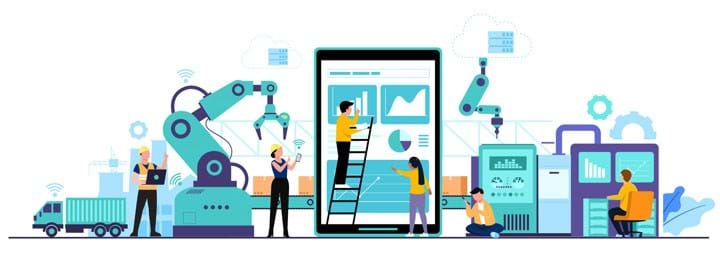
Embracing digital
Digital twin technologies, which replicate and simulate entire process operations, are a prime example of industries adapting quickly to meet the need for innovation and optimised performance. Opposed to static modelling, digital twin benefits from dynamic and more predictive modelling techniques to enhance insight into a process. Major oil and gas companies benefit from these technologies by replicating entire rigs virtually to gather sophisticated insight into wells, flow regimes, and pressures. In 2017, BP began piloting its own digital twin technology (APEX) at its North Sea ventures to help deliver an extra 30,000 bbl/d of oil and gas.1 By using data from the plant, the digital twin can assess irregularities in real time to help drive continuous optimisation. These progressions have allowed petroleum engineers to reduce their simulation run times from hours to minutes.
Several solution-driven engineering companies have acknowledged these moves to digital as being integral to evolving the field. Booth Welsh for example has a dedicated space at its facility for virtual reality (VR) and augmented reality (AR) technologies. In the last year, it has modified its AR to facilitate remote worker maintenance. This has been especially pertinent with clients and manufacturers overseas and with the stringent Covid-19 social restrictions. The company worked around these travel complications by adapting an existing AR technology, the HoloLens 2, to conduct a remote factory acceptance test for a recently-designed control panel. An engineer could live stream their point of view to clients anywhere in the world through their smartglasses. The AR was trialled, and a full 3-panel test was successfully completed without the client having to travel to site.2 Similar technologies have been developed by Siemens, Yokogowa, and ABB, who see the benefit in allowing customers to collaborate on projects remotely. The technological and cultural obstacles that once hindered the possibility of remote work have significantly reduced since the Covid-19 pandemic. Now the wheels are in motion, e-infrastructure and AR technologies like this will continue to thrive.
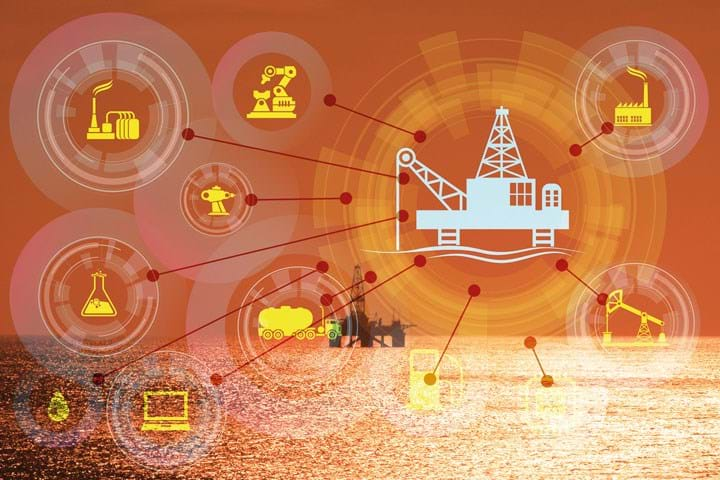
Training
Training is another instance where VR and AR technologies have flourished. VR worlds have been created to plunge workers into simulated environments where they can learn from real “what-if” scenarios. We would never expect a pilot to fly a plane without first mastering safe flight simulations, so why should we expect an engineer with potentially similar risks to do the same?
Companies such as Immerse provide VR and AR content to transform the way we learn, explore, and interact. Training is particularly important in scenarios which are dangerous and costly to recreate in real life. By creating a virtual environment for these situations, authentic training can be provided without the potential threats to safety. Immerse has designed multiple VR training scenarios, such as the recreation of safely draining a tank. In this simulation the user wears a VR headset and is guided through the task, having the ability to pick up sensors to perform gas tests, attach valve locks, and read measurements to guide decision making. An assessor can then join the simulation remotely using another headset to observe and speak to the trainee, providing real-time feedback and instruction. The potential for these models is endless, with training provided in an array of fields and disciplines using this technology. VR now exists for engineers to tour offshore plants, so that they are familiar with the layout before they arrive. Organisations such as Nestlé, Accenture, and GSK have begun adopting such solutions for use in recruitment, training, assessment, and onboarding. Mental health and wellbeing tools have also been explored, such as 360 degree meditation spaces to transport you to tranquil simulated realities.
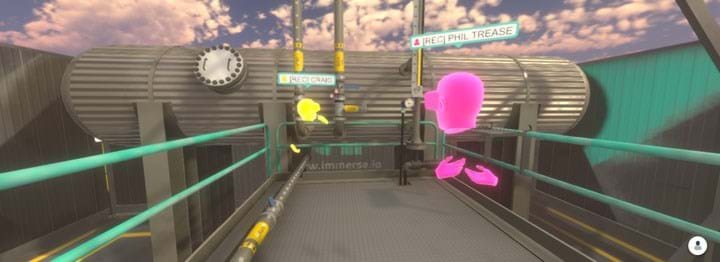
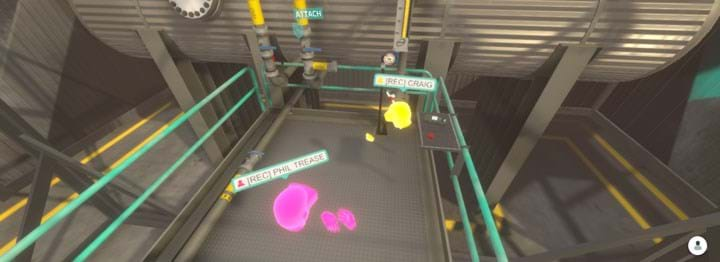
Electronic batch records
Less exciting technologies on the surface have also given companies great benefit. In the pharmaceutical, molecular science, and bioprocessing fields, tedious and lengthy manual entries for batch records are common. Digital processes such as electronic batch records (EBR) and electronic workflow lean these processes by introducing paperless manufacturing to reduce the need for these monotonous manual tasks. With the increasing complexity of drugs and compliance regulations, batch records of the past are insufficient for modern operations; many now involve hundreds of manual inputs per batch whilst also containing complex calculations which increase the likelihood of human error. Companies that have adopted EBR systems have found themselves improving compliance and reducing downstream interruption as there is less opportunity for errors to occur. Operators’ schedules have subsequently freed up to allow them to perform more fruitful tasks, improving productivity and employee morale.4
Plant, process and people
As Industry 4.0 technologies continue to develop, the hardware cost will reduce and become more accessible. Consequently, the way in which we work will change significantly as our workplaces adopt more digitalised methods. With regard to digitalisation in the process world, the three main areas of change come under plant, process, and people. Our plants and processes are clearly changing; the question now exists: With the certain drive to digital technologies, how do we as engineers adapt towards this?
It is imperative that when companies introduce new technologies it is to serve a purpose that suits the organisations’ strategies and long-term goals. Flashy, new-age technology must not be adopted as a gimmick to appear forward thinking. Many organisations suffer from choosing tech that quickly becomes obsolete and unused as it serves no real purpose to the workforce and was not chosen with a long-term goal in mind.
When executing a digital strategy, it is of the utmost importance that everyone is brought on board this journey. There is no use incorporating technology without a clear goal of successfully integrating it within the organisation. It is our responsibility as engineers and as leaders to truly understand the technology and ensure it is aligned to a forward-thinking achievable plan of where the company is going.
Creating a positive digital culture which embraces new technologies can be challenging, with many workers hesitant to use systems that require re-training and re-evaluating their roles. For us, it is crucial to step back and think about how these technologies can manifest themselves positively into our working lives. Let’s take the example of moving from your trusted older computer to a snazzier piece of tech. Yes, you love that all your photos and data are kept on your old PC; you love that it still has a compartment to put a DVD in; and of course, it’s great that you’ve fashioned a way to fix that dodgy key with Blu Tack and sticky tape. Think about all the hassle it would cause to buy a new expensive computer, move all your data, create new passwords, learn all the different functions – it sounds like a great effort. Is it worth it, even if the technology is better?
Oversimplified as that may be, this is the exact conundrum many in engineering face today. Employees who are used to running various pieces of kit often do not want to change their ways of working. Operators for instance would be naturally resistant to updating their DCS if they had been using the same operating language for many years. These systems are second nature to them and often incorporate ad-hoc code changes rendering their positions invaluable. Why would you want to change? Everything works fine, right?
Despite the attractions of new technologies, we can often be inward in our thinking, choosing what suits us at that time. Rather than be more forward-thinking, our attitudes are biased towards what is easiest in the here and now, regardless of whether that helps us achieve our long-term strategies. A recent Mckinsey study which surveyed 2,135 global executives highlighted that the largest challenge faced when businesses choose digital technologies is the cultural and behavioural barriers (see Figure)5. It is no longer a choice to address these challenges, but rather a necessity in the adoption of a digital workplace. Let’s not forget that the value of any organisation comes from the people – technology is not a substitute. We must consider why we bring in digital tools and how to incorporate them positively within an organisation.
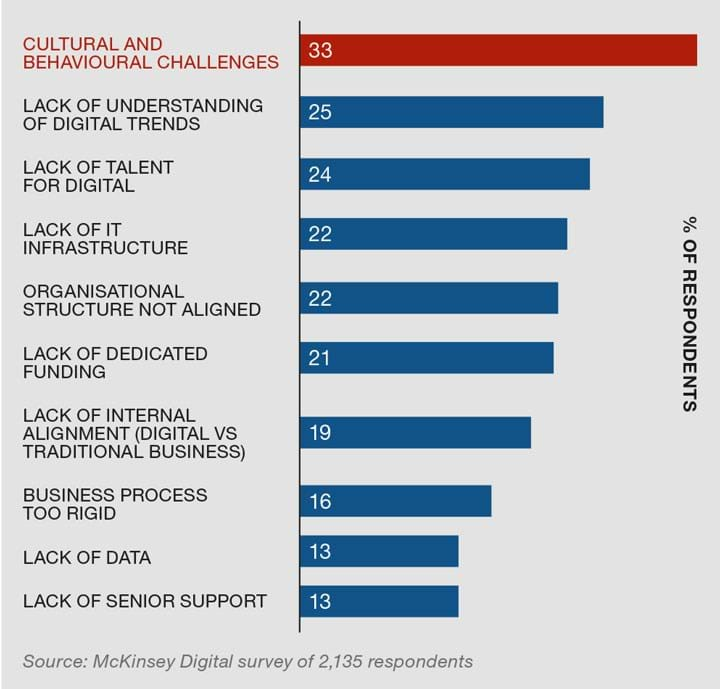
There is a fear that new technologies render old jobs redundant or that you will not be sufficiently adept in utilising new systems. It is therefore key when introducing digital solutions that it is not at the expense of an employee. A successful strategy will empower staff by removing mundane tasks from their schedules creating time to focus on more value-added operations. Employers must ensure that adequate training is provided and that the ethos behind these digital solutions is transparent. There is a great responsibility for all of us to understand why technologies may be brought in and how they can help us and the organisation in terms of efficiency, productivity, and ease of working.
My advice is to broaden your horizons to these new tools and investigate how they can improve your working experience. Open your eyes to the new and exciting; maybe it’s time to let go of some old familiarities. Yes, sometimes the best route is to stick with what you know, but with any advancement in history it has always been those who brought about change who were able to garner the most benefit. No one said that being a pioneer was a comfortable endeavour.
After all, the new digital age in our workplace isn’t coming, it’s here – and if you haven’t already embraced it you should ready yourself to do so.
References
1. Twin Win for Oil and Gas Production; BP Global, 2018; https://on.bp.com/3kMDVVS
2. Remote FAT AR Solution; Booth Welsh, https://bit.ly/3DBqLSU
3. The Immerse Content Library; https://immerse.io
4. Making the Move to Electronic Batch Records; PharmTech; 2018; https://bit.ly/3FuNyAn
5. Culture for a Digital Age; McKinsey; 2017; https://mck.co/3Cr4aao
Recent Editions
Catch up on the latest news, views and jobs from The Chemical Engineer. Below are the four latest issues. View a wider selection of the archive from within the Magazine section of this site.




